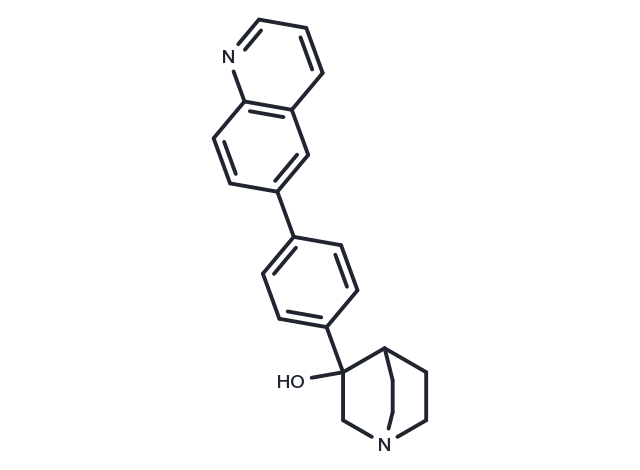Powder: -20°C for 3 years | In solvent: -80°C for 1 year


RPR107393 free base is a selective inhibitor of squalene synthase(rat liver microsomal squalene synthase, with an IC50 of 0.8 nM).

| Pack Size | Availability | Price/USD | Quantity |
|---|---|---|---|
| 25 mg | 6-8 weeks | $ 1,520.00 | |
| 50 mg | 6-8 weeks | $ 1,980.00 | |
| 100 mg | 6-8 weeks | $ 2,500.00 |
| Description | RPR107393 free base is a selective inhibitor of squalene synthase(rat liver microsomal squalene synthase, with an IC50 of 0.8 nM). |
| Targets&IC50 | Squalene synthase (rat liver microsomal):0.8±0.2 nM |
| In vitro | RPR107393 is a selective inhibitor of squalene synthase with subnanomolar potency. Rat liver microsomal squalene synthase inhibited by RPR107393 (IC50 value of 0.8±0.2 nM (n=4))[1]. Cells are treated with ER-27856 (1 μM), RPR-107393 (10 μM), Atorvastatin (1 μM), or NB-598 (1 μM) for 2-24 h, and lipid biosynthesis during the last 2 h of the incubation is determined. RPR-107393 (10 μM) inhibits Cholesterol biosynthesis and reduces triglyceride biosynthesis. Similarly, 1 μM RPR-107393 inhibits Cholesterol and triglyceride biosynthesis by 82.4% and 70.0%, respectively[2]. |
| In vivo | Cholesterol biosynthesis is significantly reduced following administration of RPR107393, demonstrating a potent cholesterol-lowering effect in rats. Specifically, a 92% reduction in cholesterol biosynthesis is observed with a dose of 5 mg/kg, peaking one hour post-administration (10 mg/kg p.o.). This effect decreases to 74% six hours post-administration at the same dosage, with the half-life for 50% inhibition being approximately 7 hours. A more pronounced effect is seen 10 hours after administering a larger dose (25 mg/kg p.o.), achieving an 82% inhibition rate; however, this effect dissipates at 21 hours. Additionally, both Zaragozic acid and RPR107393 lead to an accumulation of radiolabeled diacid products in the liver, indicating a mechanism associated with the inhibition of cholesterol biosynthesis. Remarkably, repeated doses of RPR107393 (30 mg/kg p.o. b.i.d.) result in a substantial decrease in serum cholesterol, lowering it by 35% after two days and nearly 50% after three days of treatment. |
| Molecular Weight | 330.42 |
| Formula | C22H22N2O |
| CAS No. | 197576-78-6 |
Powder: -20°C for 3 years | In solvent: -80°C for 1 year
You can also refer to dose conversion for different animals. More
bottom
Please see Inhibitor Handling Instructions for more frequently ask questions. Topics include: how to prepare stock solutions, how to store products, and cautions on cell-based assays & animal experiments, etc.
RPR107393 free base 197576-78-6 Others RPR107393 RPR 107393 RPR-107393 free base RPR-107393 inhibitor inhibit
